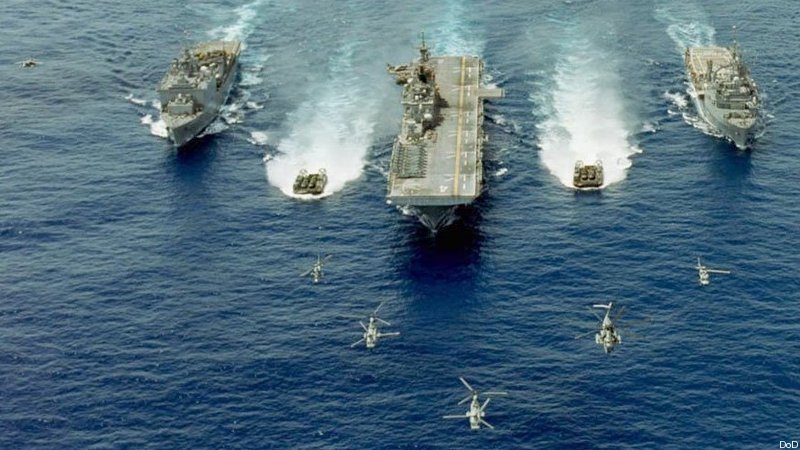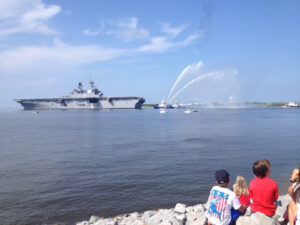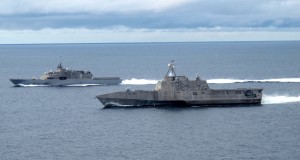
WASHINGTON: Defense Secretary Ashton Carter wants to cut the Navy’s Littoral Combat Ship program to buy more missiles, aircraft, and upgrades to ships. That’s good as far as it goes, eminent naval historian and analyst Norman Polmar told me this morning — “in my opinion the decision should have been five years ago” — but it’s not radical enough.
Polmar would like a Navy not only with fewer LCS, but with fewer aircraft carriers, the vaunted flagships of the fleet. He’d reinvest the savings not only in new munitions — which the Navy badly needs — but in more big-deck amphibious warships and a modern version of the Perry-class frigate phased out this year.

The new carrier USS Ford is afloat but still unfinished.
From Carriers To Amphibs
Let’s start with the carrier cutback, sure to be Polmar’s most controversial idea. We should “take a holiday for 10 or 15 years” on building new nuclear-powered aircraft carriers, he told me this morning. With the carrier fleet down to 10 flattops while it awaits delivery of the future USS Ford, already $2.4 billion over budget, he said, “carriers are exceedingly expensive, very limited in numbers, and limited in capabilities.” As the Navy replaced a host of specialized aircraft with multi-role F/A-18 Hornets, the carriers have become less capable.
“Over the last 20 years, our carriers have lost their long-range strike capability [the A-6],” Polmar said. “They’ve lost their anti-submarine capability [the S-3 Viking]. They have minimal combat air patrol capability because the F/A-18 is a relatively short range airplane [unlike the F-14 Tomcat], and they have a very limited tactical reconnaissance capability.”
“This isn’t going to change, Polmar said, because “we can’t afford a new generation of airplane: The Joint Strike Fighter is the only airplane on the horizon,” he said, “but we can only afford one squadron per carrier.” While the F-35C brings stealth and other new capabilities, it is still a short-ranged jack-of-all-trades like the Hornet.
That means the carriers are no longer the Navy’s best sword and shield. “If you want to kill somebody, you don’t send a group of F/A-18s, you have a destroyer or a submarine from several hundred miles away fire Tomahawk missiles,” Polmar said. “If you want to do reconnaissance you don’t send F-18s with pods on them, you use UAVs, U-2s, or satellites.”
 So what would Polmar have the Navy build instead? “I’d stop building carriers — not get rid of the ones we have — and just build more LHAs/LHDs,” he said, the so-called big-deck amphibious assault ships like the LHA-6 America or the older LHDs. The “L” stands for landing ship, and these vessels can carry nearly 1,900 Marines with equipment and vehicles. The “H” stands for helicopter, but their flight decks can also operate short-take-off-and-landing jets like the aging Harrier or the brand-new F-35B.
So what would Polmar have the Navy build instead? “I’d stop building carriers — not get rid of the ones we have — and just build more LHAs/LHDs,” he said, the so-called big-deck amphibious assault ships like the LHA-6 America or the older LHDs. The “L” stands for landing ship, and these vessels can carry nearly 1,900 Marines with equipment and vehicles. The “H” stands for helicopter, but their flight decks can also operate short-take-off-and-landing jets like the aging Harrier or the brand-new F-35B.
True, Polmar admitted, an amphib can accommodate a fraction of the fighters on a full-fledged carrier, but having Marines aboard lets it do a host of missions carriers can’t, and it’s a lot cheaper: about $3 billion compared to about $12-plus. “Ask a [theater] combatant commander where he’d rather have one more big carrier or four of these?” Polmar said.
Multiple amphibs might outperform a carrier in many peacetime missions, but they couldn’t launch and sustain as many airstrikes. From Polmar’s perspective, though, long-range firepower is what you have destroyers, cruisers, and submarines for. The problem is that we don’t have the right missiles.
“Our destroyers and cruisers are great,” Polmar emphasized, with anti-aircraft, missile defense, and anti-submarine capabilities, “except they don’t have an anti-ship missile.” About a third of the surface fleet is fitted with the outdated and short-ranged Harpoon, but “it’s an old missile,” he said. “People know how to jam and decoy it. We desperately need a new missile in the fleet for the anti-ship role.” (Two leading options are the Lockheed Long-Range Anti-Ship Missile and an anti-ship version of the Tomahawk Land Attack Missile).
Likewise, “the [Virginia-class] submarines we’re building are very good,” Polmar said, “but we’ve totally neglected the weapons: All they have are land-attack Tomahawks and Mark 48 torpedoes… Ut’s an old torpedo and the bad guys know how to counter it. We have no anti-ship missile and no mines for our submarines, and we should have both.”

The two Littoral Combat Ship variants, LCS-1 Freedom (far) and LCS-2 Independence (near).
From LCS To Frigates
A longtime critic of the Littoral Combat Ship program, Polmar shed no tears when the Defense Secretary decided to truncate it. “I was a fan of the concept, but it was so poorly executed,” Polmar told me.
“[Chief of Naval Operations Adm.] Vern Clark who started the program [in 2005] believed he could get 60 ships with a lot of capability — very specialized capability, and with no real self-defense against air or missiles, but which could do mine countermeasures, ASW [anti-submarine warfare], and anti-small craft,” Polmar said. “We still don’t have those capabilities.” LCS was designed with minimal built-in equipment and lots of room for plug-and-play “mission modules,” but “we still don’t have a missile that’s ready for production for the anti-surface module, and both the mine countermeasures and anti-submarine packages are in trouble.”
The Navy also made the maintenance and training needlessly complicated by procuring two very different designs of LCS, Polmar said. “The concept was we were going to build a couple of prototypes and then decide which to build. As it is, we are building two classes that are totally different: Their radios are different, their radars are different, their propulsion systems are different… so we need two totally different sets of spare parts, totally different sets of manuals, you can’t take a sailor from one and tomorrow put him on another.”
The Navy is now stuck with two types of LCS in service, but Carter’s plan would have them select just one design to build in 2019 and beyond. “I personally favor the LCS-1, the steel-hull design,” Polmar said. “A steel hull lasts longer [and] there is a major fire hazard with aluminum ships.” The aluminum LCS-2 admittedly has more room in its broad trimaran hull for mission modules and helicopters, Polmar said, but other than that, the LCS-1’s more traditional hull is “better organized” as well as more durable.

A Perry-class frigate, USS Vandegrift
Neither version of LCS, nor the future upgunned “frigate” version, is Polmar’s ideal of a small surface combatant. For that, he’d suggest a significantly larger and more versatile vessel that’s still smaller and cheaper than a destroyer: a 21st century version of the scrappy FFG-7 Perry-class frigate.
“These frigates were very handy ships,” Polmar said, with anti-ship, anti-aircraft, and anti-submarine capabilities. “Now, they were very lightly built, but one of them [the USS Samuel B. Roberts] struck a mine in the Persian gulf: It almost sank but the crew saved her, which surprised everyone,” he said. “Another one, the Stark…survived two Exocet missiles that exploded.”
“That’s what I believe we should be building,” Polmar said. “There are better missiles now, better radars, better towed sonars, but that type of ship.”
Multi-ship amphib buy could net $900M in savings, say Navy, Marine Corps officials
Lawmakers gave the Navy authorities to ink a multi-ship amphib deal years ago, but the service has not utilized that power yet.


























